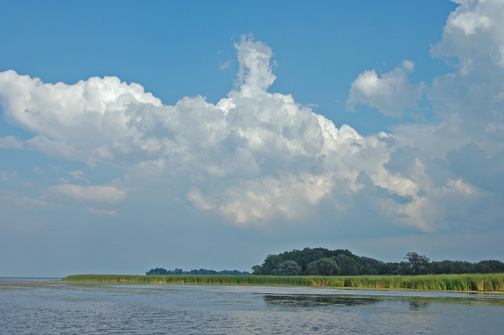"A Tern for the Better at Braddock Bay"
 |
| Black Tern – Montezuma National Wildlife Refuge © D. Sherony |
by Jim Ochterski, Rochester Birding Association Conservation Committee appearing http://rochesterbirding.com July 2014
Braddock Bay,
just west of Rochester NY, is so well known for its hawk migration observation
platform that many people forget that it is , in fact a bay. [!] Bays are inlets of water alongside large
lakes or the ocean. The mixing of landforms opens up many combinations of
dry land, partially submersed land, mud flats, dense plants, trees, and
stretches of open water. Bays are one of the most desirable habitats for
migrating and breeding birds because they offer shelter, abundant food sources,
and diverse nesting areas. Braddock Bay is part of a larger complex of
inlets and ponds that are sometimes directly connected to Lake Ontario and sometimes
not. Gravel and is shifted by lake currents and pounding waves, creating
bars and channels. When lake level regulation began in the 1950’s to
improve commercial ship navigation through the St. Lawrence Seaway, the natural
shifting was disrupted and before long, the system was almost continuously
flooded. In the wake of Hurricane Agnes, a formidable sand bar barrier
was washed away, and erosion has been hitting the lake side of Braddock Bay
very hard. [WHAT!! THERE IS A NATURAL SAND BARRIER
ALONG THE LAKE ONTARIO SIDE—PILES UP AGAINST THE MANITOU TROLLEY
FOUNDATION]
When years of
continuous flooding, erosion, and human activity combine in a freshwater area,
you can expect one thing to thrive: cattails. A fast-growing, adaptable,
and nearly invasive native plant, cattails fill in most shallow water areas
completely. In Braddock Bay, the cattails have formed a nearly lifeless
monoculture. [REALLY?] They help stabilize sediments and are home to some species,
but a lot of the habitat richness that once characterized the Bay is now
gone. Cattails can do this because the fluctuation of water levels is
very limited now. Cattails
can invade former diverse meadow marshes because sustained lake levels allow
them to survive and overtake sedges and grasses that otherwise put up with the
frequent drier soil conditions when lake levels fluctuated naturally.
Fortunately,
habitat decline in Braddock Bay caught the attention of a rather formidable
force: the US Army Corps of Engineers. In a partnership with the NYS
Department of Environmental Conservation, Ducks Unlimited, the Nature
Conservancy of Central and Western New York, and the Town of Greece, the Army
Corps of Engineers is studying how, when, and where to build, dig, and dredge
to finagle some improved coastal habitat. The target species of all this
work (an indicator of success) is the Black tern.
Black terns have
not nested in Braddock Bay in almost a generation. Even though preferred
Black tern habitat is rich in cattails, they require other plant species as
well, such as rushes, sedges, and cord grasses. In other words,
cattail monocultures are not desirable, and will not support a colonial nesting
species like the Black tern.
So, the US Army
Corps of Engineers is now conducting a feasibility study to explore if the
construction of an artificial headland breakwater, the scooping of deeper
potholes into the bay, and re-channeling areas through the cattails will bring
in plant species to restore Braddock Bay. If the habitat can be so
modified that Black terns return as an easy-to-spot nesting species, there
should be enough habitat available for other species of birds and mammals.
In the words of
the US Army Corps: “The goal of [Braddock Bay] restoration is to improve
habitat diversity of the existing emergent marsh currently dominated by
cattail, and to reduce erosion of the existing emergent marsh. The black tern
was chosen as a target species for habitat restoration, because it represents a
historic habitat no longer present in the bay. This habitat, characterized by
diverse aquatic vegetation zones, sedge grass meadows, and open water areas
interspersed within a matrix of emergent marsh, will be significantly more
ecologically diverse than the existing cattail dominated emergent wetland and
would provide high quality habitat for many species of fish and wildlife
including American mink and northern pike.” During your next visit to Braddock
Bay, look at the lackluster stand of cattails. Imagine in their place a
multi-faceted marsh habitat with swooping Black terns and hovering Northern
harriers. Then, look to the migrating hawks (mere specks in the sky) and
delight in a possible turn for the better.


 The open mouth of the Bay from time immemorial - or at least the past 10,000 years - will be damaged by the Town of Greece/Army Corps project to place breakwalls across the baymouth and dredge a channel for boaters.
The open mouth of the Bay from time immemorial - or at least the past 10,000 years - will be damaged by the Town of Greece/Army Corps project to place breakwalls across the baymouth and dredge a channel for boaters. 


